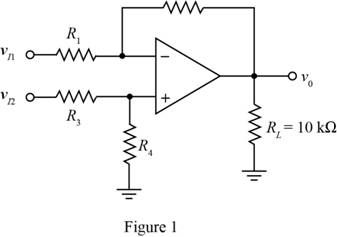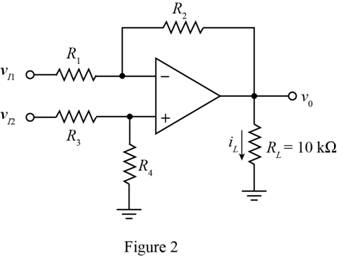
Consider the differential amplifier shown in Figure 9.24(a). Assume thateach resistor is
(a)
The value of the worst case common mode gain.
Answer to Problem 9.62P
The value of the worst case common mode gain is
Explanation of Solution
Calculation:
The given diagram is shown in Figure 1

Mark the voltages and redraw the circuit.
The required diagram is shown in Figure 2

The expression for the common mode voltage gain is given by,
The expression for the value of the voltage
The expression for the voltage
Apply KCL at the inverting terminal.
Substitute
Substitute
The expression for the common node input voltage is given by,
The expression for the common node input voltage is given by,
Substitute
Substitute
In the above equation the worst case
For worst condition the value of the resistance
For worst condition the value of the resistance
For worst condition the value of the resistance
For worst condition the value of the resistance
Substitute
Conclusion:
Therefore, the value of the worst case common mode gain is
(b)
The value of the CMRR and the common mode gain.
Answer to Problem 9.62P
The value of
Explanation of Solution
Calculation:
The expression for the common mode gain is given by,
The expression for the differential voltage is given by,
Substitute
The expression for the voltage
The expression for the common mode voltage is given by,
Substitute
Substitute
Substitute
Substitute
Substitute
The expression for the
Substitute for
Substitute
Substitute
Substitute
Substitute
Substitute
Substitute
Conclusion:
Therefore, the value of
Want to see more full solutions like this?
Chapter 9 Solutions
Microelectronics: Circuit Analysis and Design
- 11. What is the configuration of the given amplifier circuit below?12. How are the coupling capacitors treated in the figure of #11 at AC?arrow_forwardThe forward transfer function G(s) with a H(s) feedback configuration of an uncompensated Basic Satellite Launching System is as shown in figures 1 and 2. A- in the picture B- Compute the percent overshoot, peak time and settling time, using second order approximation through pole zero cancellation and unity feedback configuration shown in figure 2. C- Summarise the results (a) and (b) in tabular form and comment on the stability of both systems based on time response graph for (a) and computed values in (b).arrow_forwardWhat is the unity gain frequency and phase margin? (pls answer asap)arrow_forward
- Ignoring the “zero” in the numerator, and based only on the denominator of the closed-looptransfer-function, determine the range of constants Kp and Ki such that the rise-time of theclosed-loop system is equal (or less than) ?r =0.18 s and so that the relative damping factor ζ isequal to (or greater than) 0.8. Use the textbook approximation for the rise-time.arrow_forwardQ2. Give electrical characteristics of Ideal operational amplifier? Also show pin configuration of IC 741.arrow_forward(a) A current source with Rout = βoro is used to bias a standard bipolar differential amplifier. What is an expression for the CMRR of this amplifier for single-ended outputs?arrow_forward
- Express the voltage, current, and power gains ,a signalvi = 0.1 sin 2000πt volts Thévenin equivalent source resistance RI of 2 kΩ, and we ’d like to listen to that signal with a 32-Ω ear bud, represented by the load RL , as depicted by the circuit model in dB.arrow_forwardThe forward transfer function G(s) with a H(s) feedback configuration of an uncompensated Basic Satellite Launching System is as shown in figures 1 and 2. A- Write a m-script and generate the time and frequency response of the system shown in Figure 1. (a = 4, b = 2, c=2, d = 1and e=10, and f=4). B- Compute the percent overshoot, peak time and settling time, using second order approximation through pole zero cancellation and unity feedback configuration shown in figure 2.arrow_forwardWhat are two causes of “loading effects” in an amplifier circuit?arrow_forward
- Write the characteristics of operational amplifier.arrow_forwardConsider the unity feedback system with the following root locus for K>0. Find the approximate value of K which leads to the maximum possible overshoot of the closed loop system. Also, find all ranges of K for which the system is overdamped and as well as the steady state error to a unit step input.arrow_forwardAn IC amplifier requires a circuit that acts as high-resistance source for driving low-impedance loads so that it can be used as output stage in multistage amplifier. Which circuit best suits this application?arrow_forward
 Introductory Circuit Analysis (13th Edition)Electrical EngineeringISBN:9780133923605Author:Robert L. BoylestadPublisher:PEARSON
Introductory Circuit Analysis (13th Edition)Electrical EngineeringISBN:9780133923605Author:Robert L. BoylestadPublisher:PEARSON Delmar's Standard Textbook Of ElectricityElectrical EngineeringISBN:9781337900348Author:Stephen L. HermanPublisher:Cengage Learning
Delmar's Standard Textbook Of ElectricityElectrical EngineeringISBN:9781337900348Author:Stephen L. HermanPublisher:Cengage Learning Programmable Logic ControllersElectrical EngineeringISBN:9780073373843Author:Frank D. PetruzellaPublisher:McGraw-Hill Education
Programmable Logic ControllersElectrical EngineeringISBN:9780073373843Author:Frank D. PetruzellaPublisher:McGraw-Hill Education Fundamentals of Electric CircuitsElectrical EngineeringISBN:9780078028229Author:Charles K Alexander, Matthew SadikuPublisher:McGraw-Hill Education
Fundamentals of Electric CircuitsElectrical EngineeringISBN:9780078028229Author:Charles K Alexander, Matthew SadikuPublisher:McGraw-Hill Education Electric Circuits. (11th Edition)Electrical EngineeringISBN:9780134746968Author:James W. Nilsson, Susan RiedelPublisher:PEARSON
Electric Circuits. (11th Edition)Electrical EngineeringISBN:9780134746968Author:James W. Nilsson, Susan RiedelPublisher:PEARSON Engineering ElectromagneticsElectrical EngineeringISBN:9780078028151Author:Hayt, William H. (william Hart), Jr, BUCK, John A.Publisher:Mcgraw-hill Education,
Engineering ElectromagneticsElectrical EngineeringISBN:9780078028151Author:Hayt, William H. (william Hart), Jr, BUCK, John A.Publisher:Mcgraw-hill Education,





